Finding the right shoes and feeling comfortably supported should be your top priority if you have flat feet.
One of the things that lead to injury for many runners with flat feet is overpronation, which is when the arch falls in causing the ankle to roll in as well, sending strain up to the knee and hip. The best running shoes for flat feet can help with this, so today we’re going to look at what’s recommended and what to look for.
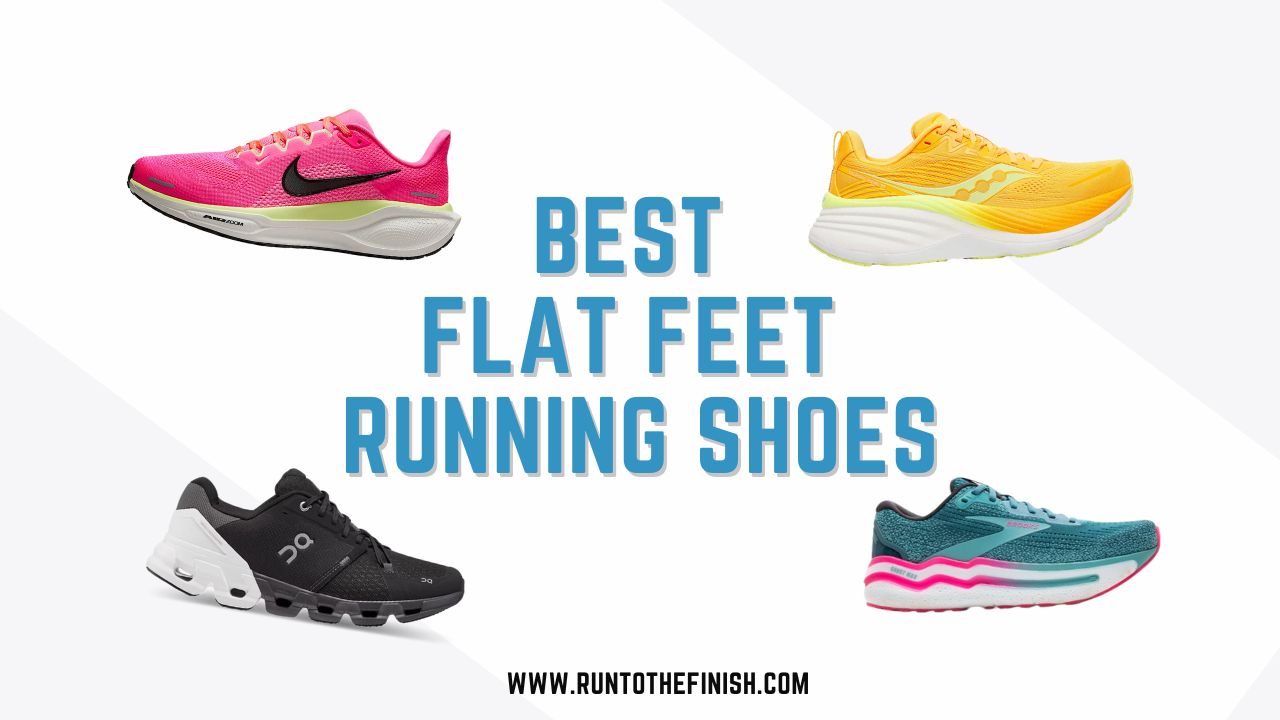
As always, I’m also a big proponent of learning to do exercises that will help your body become stronger and not rely on the shoe to do things for you.
If you don’t then over time you’ll create new areas of weakness and only mask issues for a little while. Flat feet are one exception because it’s usually a structural issue and not say weak hips.
I wrote a previous article with all the exercises and tips you need to know about running with flat feet. Today we’re to diving in to my top recommendations from 7 different brands.
You’re definitely going to find the right flat feet running shoes for yourself here! Let’s just get a couple quick things defined before we talk about shoes.
What are Flat Feet?
Flat feet, also known as fallen arches, means that the entire sole of the foot touches the ground.
Studies indicate that approximately 27% of the population has flat feet, so if this is you, you’re not alone! That’s over 1/4 of folks out there.
Runners with flat feet tend to overpronate, which is when the foot rolls inward after landing. This sends strain up the knee and hip and can lead to injury.
Often this is felt in the ankles, knees and hips making running more uncomfortable.
Each time the foot rolls inward, it pulls the knee in pulling tendons, ligaments and joints out of alignment.
For this reason, it’s important to pay attention to the type of shoes that are most suitable for flat feet. You could also look to a good running insole for support if you’ve found a shoe that you already love the feel of, but aren’t getting enough support.
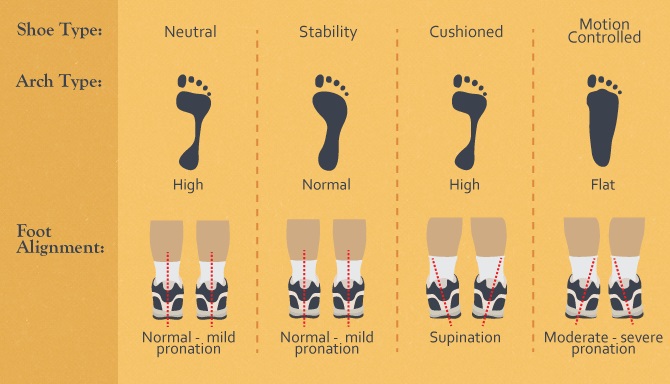
Types of Running Shoes for Flat Feet
There are a lot of different types of running shoes. But two that podiatrists recommend for runners with flat feet to help prevent pronation.
Stability Shoes
These shoes are great for runners with mildly collapsed arches or those with flexible flat feet. These shoes prioritize providing extended support for the foot arch, without being too rigid which can put stress on the feet and knees.
They’re known to deliver sufficient arch support without the added stress, and more cushioning than a neutral shoe would offer.
Motion Control Shoes
These shoes are meant for runners who have severely fallen arches, or those with rigid flat feet. These shoes restrict improper movement when running and offer strong arch support.
They’re known to help alleviate pain and discomfort by giving the most amount of stability needed to minimize arch flex and inward ankle rolling, as is the case with severe overpronators.
It’s MUCH harder to find motion control shoes now. I generally do not recommend them to the majority of runners because they can be stiff and feel like too much correction.
7 Best Running Shoes for Flat Feet
It’s important to not only know what type of flat feet you have, but to also consider how your entire body moves. This includes your hips, knees, and range of motion. If you only focus on the feet rolling in due to flat feet, but actually have week hips then you may find they continue to roll in despite adding more arch support.
My husband is someone with very flat feet. So I’ve spent a lot of time trying to find shoes that will help him feel best on the run. During my research, I’ve come across many shoes from different brands.
I absolutely recommend going into your local running store and trying on some shoes to see which one best fits your needs.
Asics for Flat Feet- Asics Gel Kayano
The Asics Gel Kayano is an excellent choice for those with flat feet or who tend to overpronate. This means the shoe is going to feel a bit firmer to provide that support on the inside of your foot to keep it from collapsing inward.
These shoes offer superior support to reduce fatigue, as well as a secure fit that won’t slip or slide while in motion. On top of that, the heel-locking system helps keep your foot in place providing even more stability and comfort on longer walks.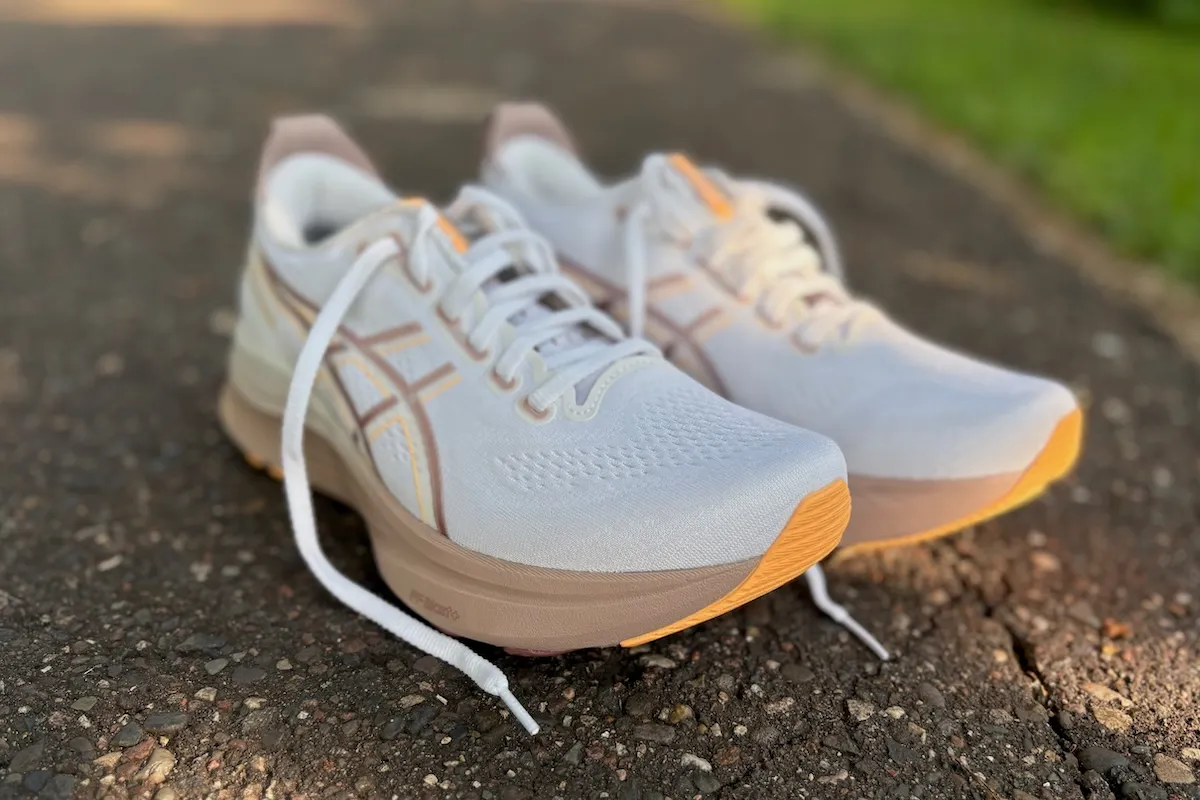
The stability of the Kayano 32 comes from the 4D Guidance System, a pod designed to adaptively respond as you hit the ground. This plus the wider base make the shoe a good ride for neutral and overpronaters alike.
The ASICS GEL Kayano was first released in 1993 and due to its popularity is now on the 32nd edition!
Trust me, these are incredible shoes that are especially ideal for anyone with flat feet.
- Weight: 10.7 oz Men’s, 9.1 oz Women’s
- Stack Height: 40 mm
- Heel Drop: 8 mm
- Available in 9 colors
- Available in wide and narrow
- Available at Asics.com for $165.00
- Check out our full review of the Asics Gel Kayano 32 here >>
New Balance for Flat Feet- New Balance Fresh Foam 860
While New Balance is largely known for having extra widths to accommodate wider feet, they do have a great option for flat-footed runners as well.
The New Balance Fresh Foam 860 has a dual-density medial post in the midsole that helps with overpronation, which will stabilize your foot strike and help to keep you in better alignment.
A combination of hard and soft rubbers on the outsole of the Fresh Foam 860 imparts grip, while the firm midsole is useful at runs of a higher pace.
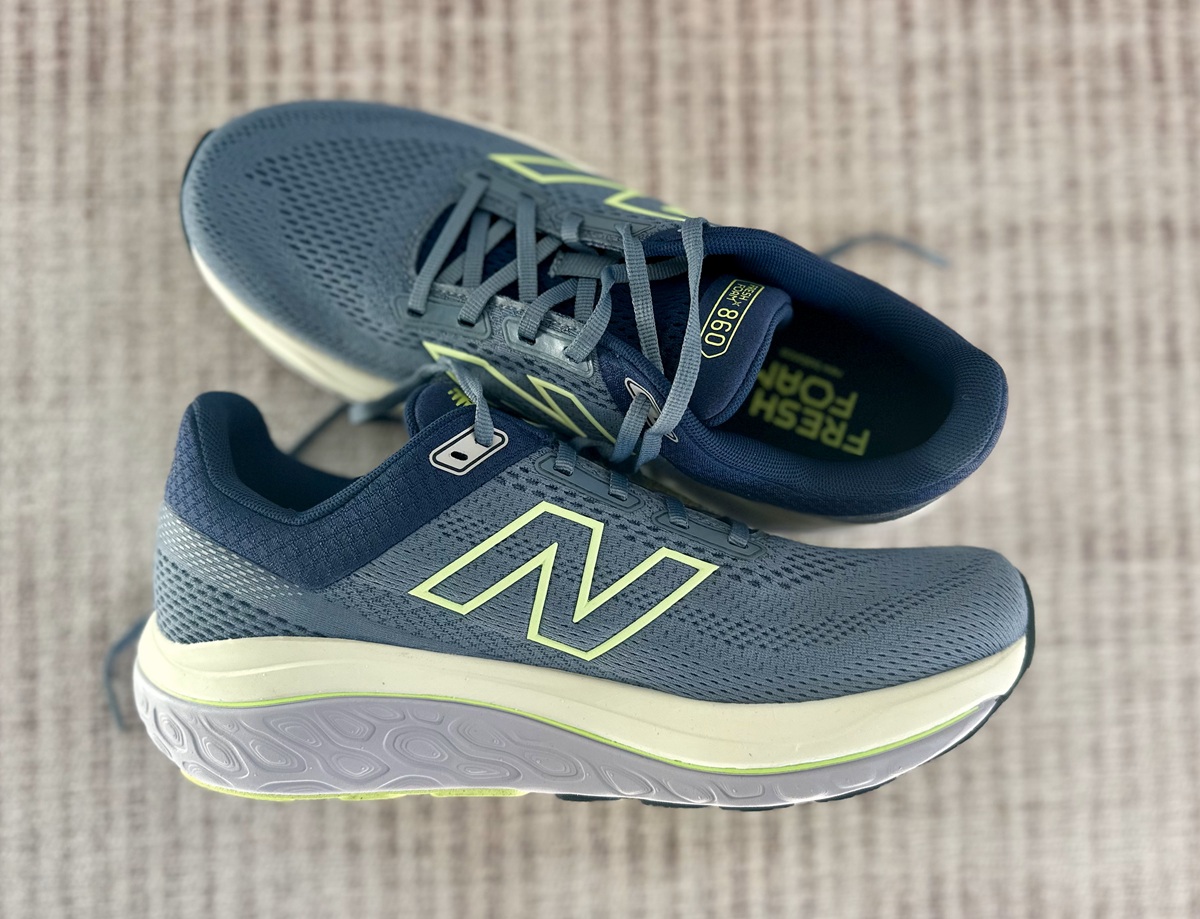
The updated Fresh Foam X midsole provides more cushioning than before. With 38mm in the heel and 30mm in the forefoot (up from 35mm and 25mm in the v13), it feels softer underfoot while still maintaining the firmness needed for stability.
The breathable mesh upper keeps your feet cool and secure, and the cushioning is second to none.
It’s a stability running shoe that’s surprisingly light. It has a stretchy, spacious forefoot and toe box which feels comfortable and not too loose or sloppy.
- Weight: 10.8 oz Men’s, 8.7 oz Women’s
- Heel Drop: 8 mm
- Stack Height: 38mm
- Available in core and seasonal colors
- Available in narrow, wide and extra wide (in limited colors)
- Available on Newbalance.com for $140
- Read our full review of the New Balance 860v14 here >>
There are A LOT Of fresh foam numbered shoes, so note that the 880 is neutral cushion. The 860 is the stability option.
Brooks Running Shoes for Flat Feet- Ghost Max 3
Brooks has several running shoes that offer great stability, including the super popular Brooks Adrenaline GTS, but specifically for flat feet, there’s a lot of hype around the Ghost Max 3.
While this is not a stability shoe, it’s going to offer a naturally stable feel with moderate (but firmer) cushioning, making it a good choice for anyone who already loves the fit and feel of a Brooks shoe.
Brooks upped the cushioning here and used nitrogen-infused DNA LOFT v3 foam in the midsole to help provide a softer landing. But keep in mind that this will not have that max cushion feel
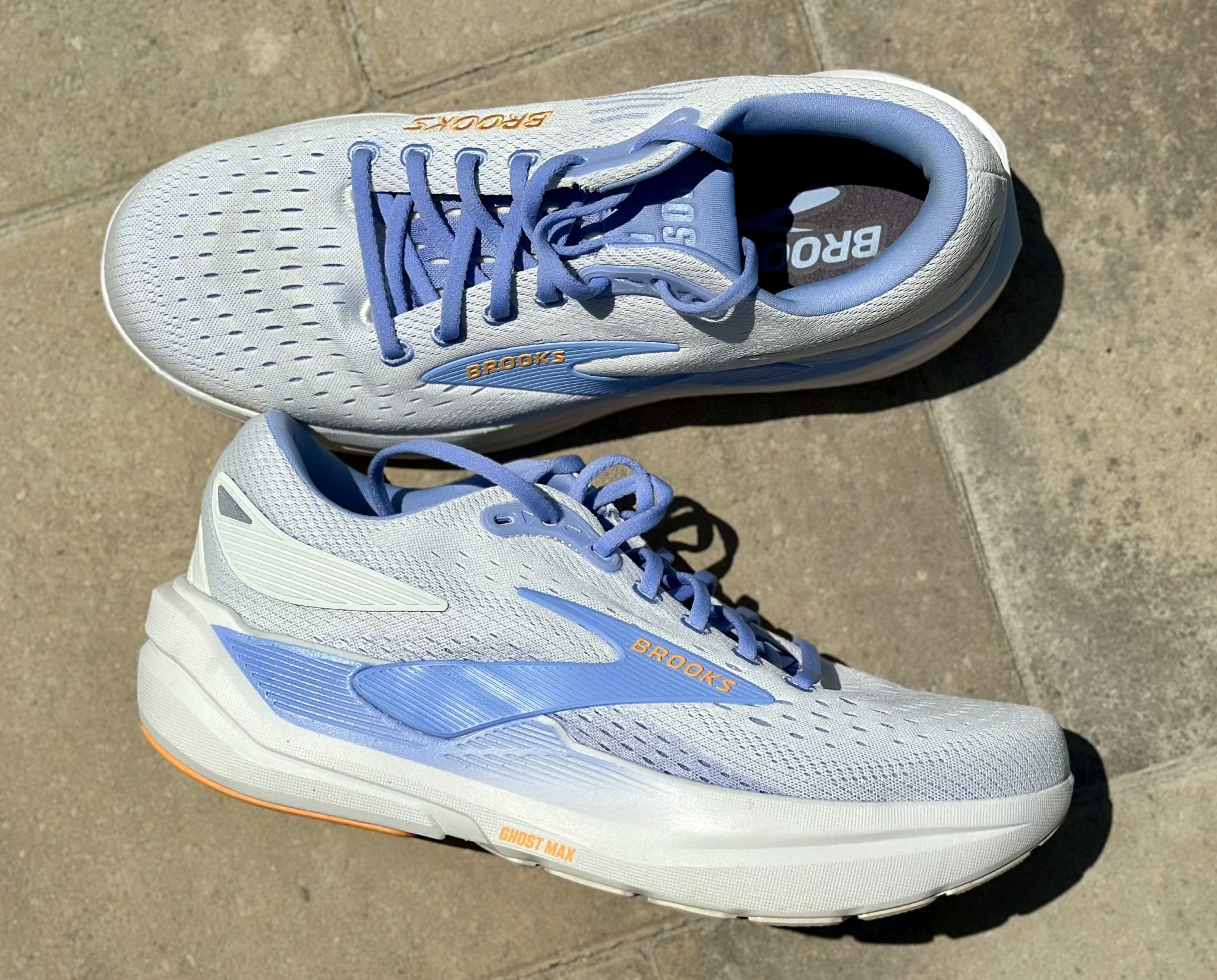
How is this different from the Ghost? Well, max generally means we’re getting a bigger stack height so they can shove in a lot more cushion and it will feel softer underfoot. Again, the word softer here is a different feeling from what you would get from a shoe like the New Balance 1080.
The Ghost Max 3 is going to feature the GlideRoll Rocker to help that heel to toe transition feel more natural. This is going to be an especially great shoe for long hours on your feet, whether at work or walking on vacation!
- Heel toe drop: 6 mm
- Weight: 9.7 oz women’s, 10.8 oz men’s
- Stack: 39 mm
- Available in 9 colors
- Available in Wide and Extra Wide in select colorways
- Available from Brooksrunning.com for $150
- Read our full review of the Brooks Ghost Max 3 here >>
Nike Running Shoes for Flat Feet- Nike Pegasus
The Nike Pegasus 41 uses the Nike React foam midsoles that are not only lightweight but also springy and durable. Rather than feeling bouncy, this is just a nice amount of cushion that allows you to still get a quick rebound off the ground. The breathable mesh upper provides a great neutral fit that will be good for many runners.
During a steady run, my husband, even with his flat feet, noted that “this shoe felt really good the whole way, plenty of support so my knees felt good and the cushion was really nice.”
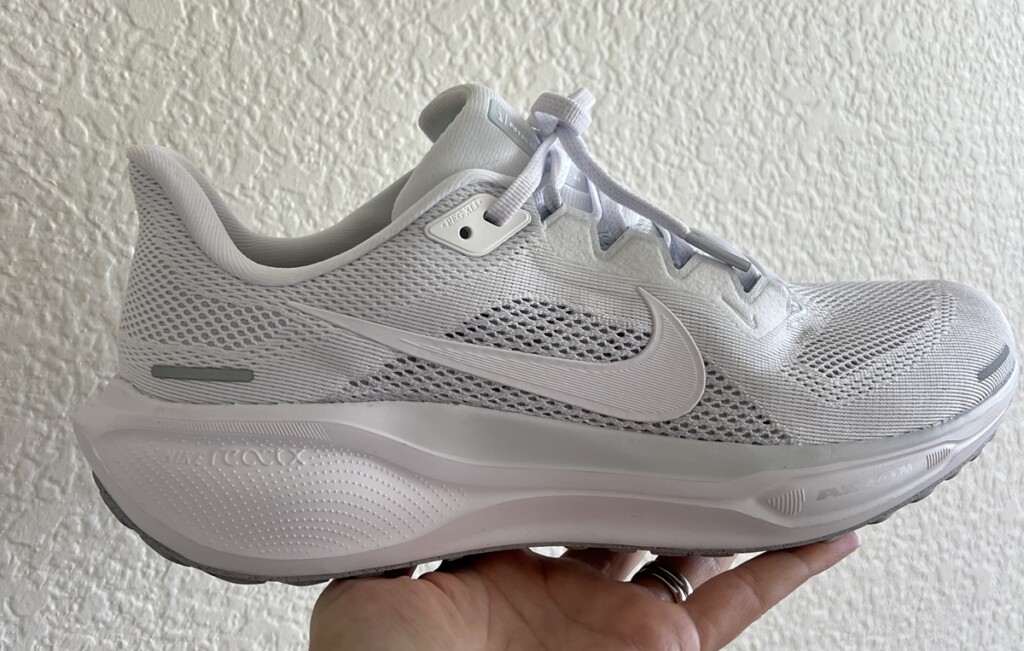
The Pegasus also features a wider toe box for more room while its curved collars help reduce irritation to the Achilles tendons. I definitely understand why this shoe has made it to model 41 and is so extremely popular.
The Pegasus is a long time shoe for Nike, which to me is always a signal of a great model.
- Heel drop: 10mm
- Weight: 10.4 oz men’s, 8.6 oz women’s
- Moderate cushion, lower stack height than others
- Available in Extra Wide
- Find it here on Nike.com for $140, so you can enjoy their 30 day trial policy!
- See complete Nike Pegasus 41 Review >>
Nike has a great return policy, so I like to buy direct. Then you can go for a few runs and return if it feels awful.
Saucony Running Shoes for Flat Feet- Saucony Hurricane
For many years I ran nearly every race in the Saucony Kinvara, which is the polar opposite of a stability shoe. It’s a more low profile minimal shoe and yet I see many folks with low arches end up in a shoe like this. It might initially feel good to not have the arch support, but your body will thank you for picking a shoe with it.
The Saucony Guide often comes up for stability, but the Hurricane is going to provide you with the most support for flat feet.

The Saucony Hurricane 24 is the most well-cushioned and stable daily trainer from Saucony. It includes their premium foam and is an impressive shoe that combines plushness and responsiveness.
- Weight: 10.6oz Men ‘s, 9.8oz Women’s
- Heel Drop: 6 mm
- Stability Shoe
- Max cushion
- 11 colors
- Available in wide
- Available on Saucony.com for $160
- Check out our full review of the Saucony Hurricane >>
Hoka Running Shoes for Flat Feet- Hoka One One Arahi 8
The Hoka One One Arahi 8 is an excellent example of how stability shoes can still feel lightweight and responsive without feeling clunky or bulky.
If you’re a runner with slightly wider feet, this might be the best shoe for you with its open construction and roomy forefoot section. It’s definitely one of a kind when it comes to stability shoes with its lightweight construction and responsive cushioning.
Hoka switched from J-Frame stability to H-Frame stability technology. This shifted the support from just the medial side (or inside) of the foot to both the medial and lateral sides allows the shoe to keep the material directly under the forefoot and heel making it a more balanced and less stiff ride, great for overpronators.
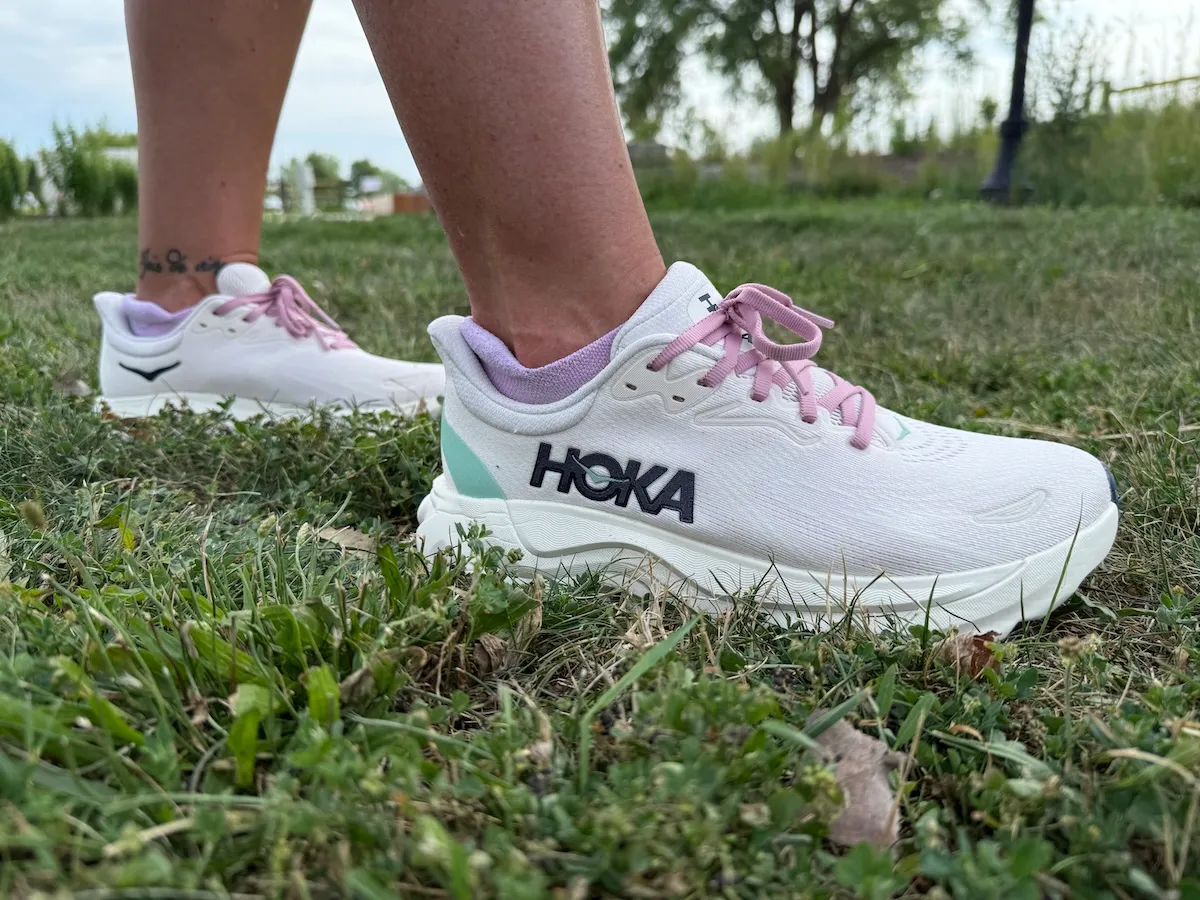
This shoe is great for easy and long training runs, especially with extra space in the toebox.
Even with an additional 3mm of foam from previous models this shoe felt light and had a little bounce to it— if you’re someone who needs a lot of support and prefers a more rigid shoe, this might not be the choice for you.
- Weight: 9.8 oz Men’s, 7.7 oz Women’s
- Stack Height: 39 mm
- Heel Drop: 8 mm
- Available in 6 colors
- Available in wide and extra wide
- Available on hoka.com for $150.00
- Check out our full review of the Hoka Arahi 8 here >>
On Running Shoes for Flat Feet- On Cloudflyer 5
The Cloudflyer 5 is a plush running shoe with enhanced stability. The parts beneath the shoe are wider than in previous models, and they’re designed to aid limit inward rotation, making theCloudflyer ideal for persons with flat feet, overpronation, or who want a little extra support.

For even more support, the latest version also has a molded sockliner and a heel counter on the outside. We really liked this addition to the shoe and it’s a bonus if you’re someone that is on their feet all day.
One of the biggest changes is the removal of the speedboard polymer plate in the midsole. On decided to do away with this to help provide that plush feel.
Unfortunately, we just don’t agree with it being plush… maybe slightly softer than the 4. If you liked the Cloudflyer 4, chances are you’ll still be a fan of this one.
Just like the On website describes, the Cloudflyer 5 gives a “foot-hugging feel” straight out of the box.
- Weight: 8.8 oz women’s, 10.6 oz men’s
- Heel drop: 9mm
- Available in 5 colors
- Available from On Running for $170
- Read our full review of the On Cloudflyer 5 here >>
Why It’s Important to Choose the Right Running Shoes for Flat Feet
We all want to be able to focus on enjoying our runs, and wearing the right footwear can help you do so by reducing pain and preventing injuries.
The best running shoes for flat feet are those that provide the necessary support and stability while also cushioning and protecting your feet from impact.
With the proper footwear, you can prevent overpronation. This happens when your foot rolls excessively inward during running, causing strain on your feet and legs.
The right shoes can not only help you avoid pain and injuries, but they can also help you run better. You may improve your running form and stride with the correct support and cushioning, which will make your runs more efficient and you’ll enjoy them even more!
Investing in the proper running shoes can have a significant impact on your running experience. With a good pair of running shoes, you can hit the pavement with confidence and relish in the benefits of running.
Factors to Consider When Picking Running Shoes For Flat Feet
Here are some of the most important factors to consider when picking the right shoes for your flat feet:
Type of Flat Feet
Some runners have anatomically flat feet, while others experience ‘collapsed arches,’ when the arch collapses due to a lack of muscle strength. Even though the two can look very identical, the way you buy shoes for them is very different.
When it comes to shopping for a shoe for a flat-footed runner with collapsed arches due to muscle weakness, you can add arch support until the foot gets stronger and can support its own arch.
However, with an anatomically flat foot, arch support simply transfers tension to the knee, which can cause knee problems.
Before choosing a shoe, it’s important to know what kind of flat foot you have and how it affects your knees, hips, and range of motion, in addition to your foot.
Level Of Support
There are three main types of running shoes to choose from, namely neutral, stability, and motion control shoes.
Neutral shoes provide no extra support along the medial edge, so these aren’t a good option for flat feet. Stability shoes strike a balance between support and cushioning, and motion-control shoes offer great support and structure.
The design of motion control shoes places the foot in a more neutral position, allowing for a more efficient gait cycle when running or walking. These shoes are ideal for runners with severe overpronation.
But if your flat feet only cause you mild pain, you may want to choose a soft stability shoe that combines comfort and support. If you’re unsure of how much support you require, it may be helpful to consult a podiatrist to determine how the anatomy of your foot affects you while you run.
Shoe Fit
Flat feet are frequently associated with wide feet because the lack of an arch puts more of your foot in contact with the floor, resulting in a bigger footprint. Many people who have flat feet can benefit from wearing shoes with a roomy toe box such as wide running shoes.

But you should still think about the shape of your forefoot, midfoot, and heel before buying a shoe. For instance, a significant amount of a shoe’s support comes from the heel, which maintains contact between the sole of your foot and the shoe. So, choose a shoe with a tighter fit if your heel is narrow to prevent it from rising and falling with each step.
Cushioning
The fact that you have flat feet does not mean you should avoid cushioning, but a stiffer shoe will often work better for you. But still, there are some runners with flat feet who like shoes with more cushioning and shock absorption because it makes them feel better.
You might be able to figure out what you like by looking at the shoes you wear every day, or you might have to try out different kinds to find the right amount of cushioning for you.
Running Insoles
As noted this is another really good option. In fact, David was resistant to changing shoes, but was starting to have Plantar Fasciitis issues and knee pain.
In testing a few different styles here is what we found:
- Superfeet provide a lot of support, but are very firm..
- VKTRY Carbon fiber insoles also provide a lot of support, plus the bonus of carbon fiber. Also very firm.
- Sole Medium insoles have been a really good light cushion, plus support
- Spenco is great for cushion, but low on the firm arch support (can be good if you don’t have completely fallen arches).

All right there you have some of my top picks for flat feet running shoes. I hope this gives you a place to start your search.
Don’t be afraid to go to a running store and run around the block! Or truly checkout the return policy for many places. You will often be surprised to find that you could take them out for a couple runs and then return them because you don’t like the way they feel.
Looking for more running shoe info?
- Full breakdown of the Hoka Running Shoes
- When to Replace Running Shoes?
- How to Clean Your Running Shoes?
- Best Hoka Walking Shoes
- Best Wide Toe Box Running Shoes
Other ways to connect with Amanda
Instagram Daily Fun: RunToTheFinish
Facebook Community Chatter: RunToTheFinish
Sign Up to Receive a Weekly Newsletter with Top Running Tips and Laughs



 Tracksmith Eliot Range Review: A Strong Trail Return That Needs Fine-Tuning
Tracksmith Eliot Range Review: A Strong Trail Return That Needs Fine-Tuning